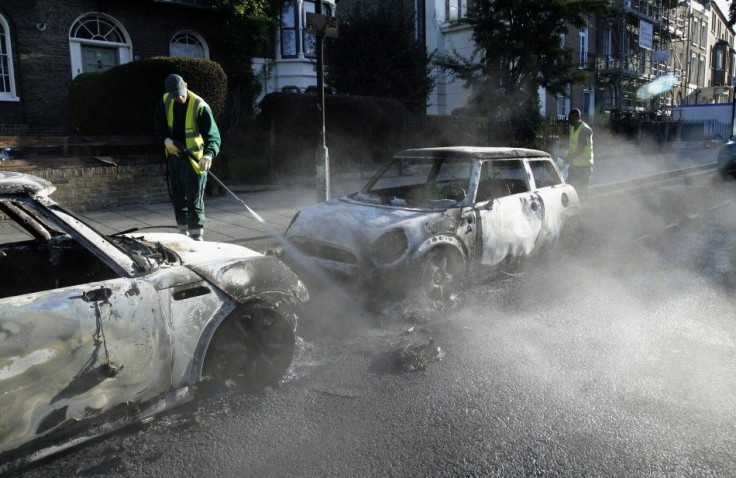London Riots: 26-Year-Old Shot in Car Becomes First Fatality
ANALYSIS

A 26-year-old man shot in a car in Croydon, south of London, during this week's riots has died, becoming the first fatality of the chaos sweeping Britain, the BBC reported on Tuesday.
What started as a peaceful protest in the North London neighborhood of Tottenham has quickly become a citywide disaster, following three days of violence that has swept through several outer neighborhoods. The unrest reportedly has engulfed several districts, including Hackney in east London and Peckham and Lewisham in south London.
Demonstrators and hooded youths threw firebombs at police officers and torched property. In Tottenham, rioters smashed store windows and burned buildings to the ground.
The turmoil has mostly affected low-income and multi-ethnic neighborhoods, whose residents feel disenfranchised and face high unemployment. The police shooting of Mark Duggan, the father of four, in Tottenham, sparked the violence. Mounted police officers and riot police responded to the unrest by charging protesters, possibly escalating the violence.
Authorities have promised that further demonstrations will be met with the full power of the Metropolitan Police Force.
"Should we receive any indication that there will be any further violence or offending, there is a robust policing plan in place and we will respond appropriately with the resources available to us," Police Commander Adrian Hanstock told Reuters.
Despite the warning, rioters in Peckhman in South London on Monday afternoon set fire to a building and a number of cars. There has also been widespread looting targeting electrical stores and mobile phone stores.
Dozens of police officers have been injured and scores of rioters have been jailed. Authorities said that so far a total of 215 people have been arrested and 27 people have charged in connection with the disturbances.
"The violence we've seen, the looting we've seen, the thuggery we've seen, this is sheer criminality," said Home Secretary Theresa May. "These people will be brought to justice. They will be made to face the consequences of their actions."
The unrest, however, that has made news around the world is likely about more than just the death of Duggan. Critics say the violence is also an outflow of frustration.
Like many European cities, London is in the midst of serious fiscal inadequacies, and poor neighborhoods such as Tottenham and Hackney have suffered the most. Unemployment is rampant in such areas, especially in North London.
"Tottenham is a deprived area," recently laid-off Uzodinma Wigwe told Reuters. "Unemployment is very, very high ... they are frustrated."
"We know we have been victimized by this government, we know we are being neglected by the government," said a middle-aged man who declined to give his name. "How can you make one million youths unemployed and expect us to sit down?"
Metro police, as well as a private agency, are investigating the riots and the shooting.
The violence has marred otherwise peaceful rallies in London against government austerity measures.
In March, isolated clashes erupted in London between police and protestors marching from Piccadilly Circus to Hyde Park to Parliament. Police fired tear gas on the protestors, who in turn threw rocks, bottles, paint and light bulbs filled with ammonia at the police officers. That clash injured 31 police officers and led to the arrest of 214 people.
On Piccadilly, across the street from the Ritz Hotel, people wearing scarves and T-shirts over their faces broke the windows of an HSBC bank and a Starbucks coffee shop, while spray-painting everything they could find, including telephone booths, mail boxes, storefronts and even the street itself. The instigators also stormed and occupied the luxury department store Fortnum & Mason and a number of clothing stores on Oxford Street.
Earlier in the year, student protests against a tuition hike also turned violent, with students and police clashing on London streets. Demonstrators broke out shop windows and attacked Prince Charles' Rolls Royce as it rolled down Regent Street.
© Copyright IBTimes 2025. All rights reserved.





















